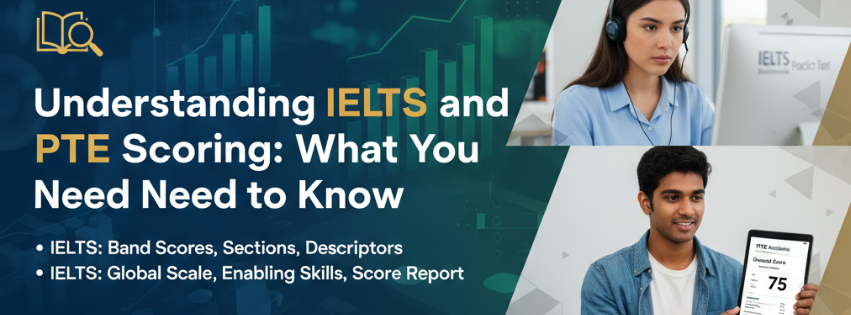
If you’re planning to study or work abroad, chances are you’ve come across IELTS and PTE, the two most popular English proficiency tests. While both exams assess your English skills, understanding how they are scored is crucial to achieving your target score and planning your preparation effectively.
In this blog, we’ll break down IELTS and PTE scoring in a simple way, so you know exactly what to focus on.
1. IELTS Scoring Explained
IELTS (International English Language Testing System) evaluates your English in four sections: Listening, Reading, Writing, and Speaking. Each section is scored from 0 to 9, and your overall band score is the average of the four.
Listening and Reading: Each correct answer gives you points, which are converted to a band score from 0–9.
Writing: Evaluated on task achievement, coherence, vocabulary, grammar, and spelling.
Speaking: Assessed based on fluency, pronunciation, grammar, and vocabulary.
Example: If your Listening is 7.5, Reading 8, Writing 7, and Speaking 7.5, your overall band would be:
Tip: Each half band counts. Even small improvements in one section can boost your overall score.
2. PTE Scoring Explained
PTE (Pearson Test of English) Academic also tests Speaking, Writing, Reading, and Listening, but it uses a scored points system from 10–90 instead of bands. Your final score is the average of the four sections, and it reflects your ability in real-life English communication.
Speaking & Writing: Evaluated together for pronunciation, fluency, grammar, vocabulary, and written content.
Reading: Assessed on understanding texts, multiple-choice, and re-ordering tasks.
Listening: Focused on your ability to understand conversations, lectures, and summaries.
Tip: PTE provides detailed skill scores, like grammar, oral fluency, pronunciation, and vocabulary, which helps you know exactly which areas need improvement.
3. Key Differences Between IELTS and PTE Scoring
| Feature | IELTS | PTE |
|---|---|---|
| Score Range | 0–9 (bands) | 10–90 (points) |
| Skill Focus | Each section scored individually; overall band is average | Each section scored; detailed skill scores given |
| Writing & Speaking | Evaluated separately | Speaking & Writing combined score |
| Reporting | Only band scores reported | Detailed skill scores reported |
| Recognition | Widely recognized globally | Increasingly accepted by universities and immigration |
Bottom line: IELTS gives a simple band score that universities and immigration offices understand easily. PTE provides a more detailed report, which can help pinpoint strengths and weaknesses.
4. How to Use Your Score to Improve
Know the requirements: Universities and visa programs often have minimum scores. For example, IELTS 6.5 or PTE 65.
Target your weak areas: Use section or skill scores to focus your practice where it matters most.
Practice realistically: Simulate exam conditions to get accurate scores and track improvement.
Plan your retakes: Both exams allow multiple attempts, so focus on consistent improvement.
5. Final Thoughts
Understanding how IELTS and PTE are scored is not just about knowing numbers—it’s about preparing strategically. Focus on improving one skill at a time, track your progress, and target the score required for your goals.
With the right approach, achieving your desired score is completely possible. And remember, small improvements in one section can make a significant difference to your overall result.
Empowering students with expert guidance for academic success. Your trusted partner in achieving educational goals.
Quick Links
Get In Touch
Birendra Campus Gate Bharatpur-10, Chitwan
hanamijapaneselanguage@gmail.com
056-493528 | 9855046493 | 9802924800
Copyright © Hanami | All Rights Reserved. Designed by Paradise InfoTech














